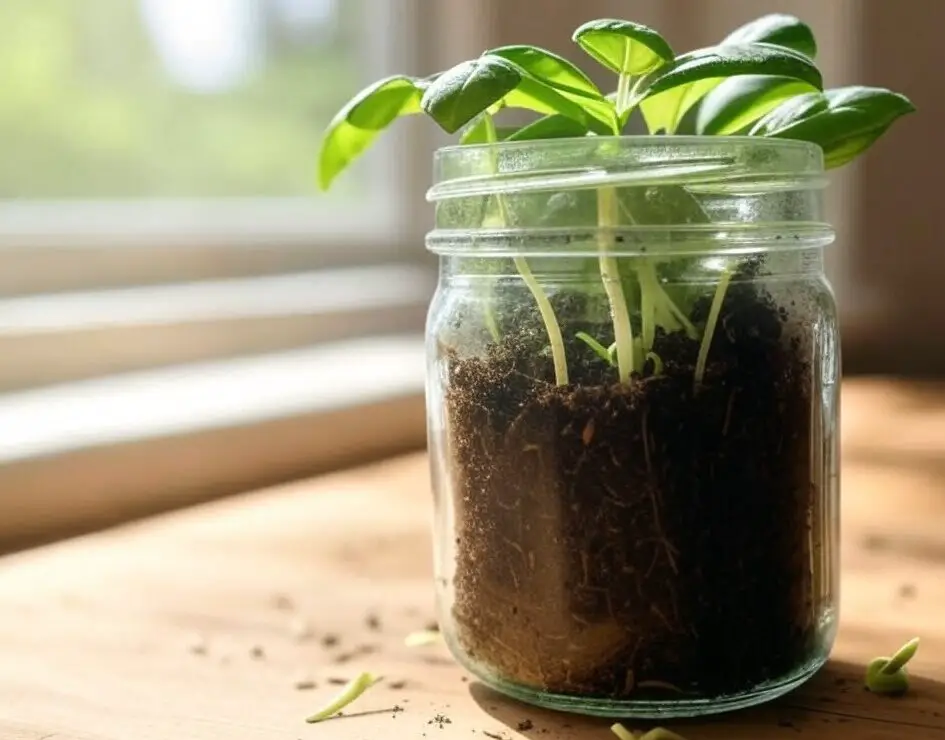Growing basil in a mason jar from seeds is a simple and rewarding project that allows you to enjoy fresh herbs year-round, even in small spaces.
This guide will walk you through the process, covering everything from materials needed to troubleshooting common issues.
Materials Needed
- Mason jar with a lid
- Potting soil
- Basil seeds
- Water
- Optional: Fertilizer, small rocks or pebbles
Step-by-Step Instructions
Preparing the Mason Jar
Start by cleaning the mason jar thoroughly. If using rocks or pebbles, place them at the bottom for drainage. Add potting soil, leaving enough space for the seeds and watering.
Planting the Seeds
Sow the basil seeds about ¼ inch deep in the soil. Cover the jar to maintain humidity and place it in a sunny spot. Keep the soil moist but not waterlogged.
Providing Light and Care
Once sprouted, ensure the jar gets at least 4-6 hours of sunlight daily. Water gently and consider using a homemade fertilizer for optimal growth.
Common Challenges and Solutions
Overwatering
Check the soil moisture by sticking your finger into the soil up to the first knuckle. Water only if the soil feels dry. For more tips on watering, visit our guide on watering indoor plants.
Pests
Inspect your basil regularly for pests. If you find any, treat the plant with a natural pesticide. Learn more about natural pest control methods.
Insufficient Sunlight
- Basil requires at least 6-8 hours of sunlight per day. If growing indoors, place the mason jar near a south-facing window or use a grow light.
- Rotate the jar every few days to ensure even light exposure and prevent leggy growth.
Slow or Poor Germination
- Basil seeds need warmth to sprout. Keep the jar in a warm spot (around 70°F or 21°C) and cover the top loosely with plastic wrap to create a greenhouse effect until the seeds sprout.
- Use fresh, high-quality basil seeds, as older seeds may have lower germination rates.
- Water lightly and consistently—too much water can drown seeds, while too little can cause them to dry out before germinating.
Leggy Growth
- If your basil seedlings grow tall and spindly, they may not be receiving enough light. Move them closer to a light source.
- Pinch off the top leaves regularly to encourage bushy growth and prevent the plant from becoming weak.
Nutrient Deficiency
- Since mason jars do not have much soil, nutrients can deplete quickly. Feed your basil with a diluted liquid fertilizer or compost tea every 2-3 weeks.
- Avoid over-fertilizing, as too much nitrogen can lead to excessive leaf growth with less flavor.
Mold or Fungus Growth
- Poor air circulation and excess moisture can lead to mold on the soil surface. Allow the topsoil to dry slightly between watering.
- If you notice mold, scrape off the affected soil and sprinkle a bit of cinnamon or activated charcoal on the surface to prevent further growth.
Root Bound Plants
- Since mason jars are small, basil roots can become crowded over time. If growth slows down, consider transplanting the basil into a larger container or trimming the roots carefully when repotting.
Practical Tips for Success
- Use a well-draining potting mix to prevent root rot. A mix containing perlite, vermiculite, or sand helps maintain proper aeration and drainage. Avoid heavy garden soil that retains too much moisture.
- Choose the right container with drainage holes to prevent water from accumulating at the bottom, which can lead to fungal issues and root diseases. If using a jar or container without holes, add a layer of pebbles at the bottom to improve drainage.
- Prune the basil regularly by pinching off the top leaves to encourage bushy growth. This prevents the plant from becoming leggy and helps it produce more flavorful leaves. Remove any flowers as soon as they appear to keep the plant focused on leaf production.
- Water consistently but avoid overwatering. Basil prefers slightly moist soil but does not tolerate standing water. Check the top inch of soil—if it feels dry, it’s time to water.
- Provide ample sunlight. Basil thrives in bright, indirect light or at least 6-8 hours of direct sunlight per day. If growing indoors, place the plant near a sunny window or use a grow light.
- Feed with a balanced fertilizer every few weeks to ensure healthy growth. Organic compost or a diluted liquid fertilizer can help maintain nutrient levels.
- Keep the jar away from extreme temperatures and drafts. Basil is sensitive to sudden temperature changes, so avoid placing it near air conditioners, heating vents, or open windows with strong winds. The ideal temperature range is between 65-85°F (18-29°C).
- Rotate the plant occasionally to ensure even light exposure and prevent it from leaning toward one side.
- Harvest leaves correctly by picking from the top rather than stripping leaves from the bottom, which can weaken the plant. Use fresh leaves regularly to encourage continued growth.
Creative Uses for Your Homegrown Basil
- Enhance your meals: Add fresh basil leaves to salads, pasta dishes, sandwiches, and homemade pesto for a burst of flavor. Mix it into scrambled eggs, omelets, or grilled vegetables for a fresh twist.
- Create flavorful drinks: Use basil as a garnish for cocktails, mocktails, or infused water. Try muddling basil with lemon and honey for a refreshing basil lemonade or adding it to mojitos and gin-based drinks for a unique herbal touch.
- Make homemade basil oil or vinegar: Infuse olive oil with basil for a fragrant drizzle over roasted vegetables, pasta, or bruschetta. Basil-infused vinegar can add depth to salad dressings and marinades.
- Upgrade your soups and sauces: Stir chopped basil into tomato soup, minestrone, or creamy bisques just before serving. Blend it into homemade tomato sauce, curry, or stir-fry for extra aroma and taste.
- Bake with basil: Experiment by adding finely chopped basil to bread, pizza dough, or even desserts like lemon-basil shortbread cookies and basil-infused ice cream.
- Make basil butter or spreads: Blend fresh basil with softened butter, garlic, and a pinch of salt for a delicious spread on bread, grilled meats, or roasted corn. Combine basil with cream cheese or Greek yogurt for a tasty dip.
- Create basil-based herbal tea: Steep fresh basil leaves in hot water with honey and lemon for a soothing, aromatic tea that aids digestion and relaxation.
- Use it in homemade skincare: Basil has antibacterial properties—blend it into DIY face masks or herbal steam treatments for a refreshing skin boost.
- Dry and store for future use: Preserve your basil by drying the leaves or freezing them in ice cube trays with olive oil. This way, you can enjoy homegrown basil even when it’s out of season.
- Make a basil-scented home spray: Infuse basil in water or mix its essential oil with distilled water to create a natural, refreshing room spray.
Frequently Asked Questions
Basil seeds typically germinate within 7-10 days under optimal conditions.
Yes, basil can be grown indoors year-round if provided with sufficient light and proper care.
Yellow leaves may indicate overwatering, underwatering, or too much direct sunlight. Adjust your watering schedule and ensure the plant is in a bright, indirectly sunny location.
Water your basil when the top inch of soil feels dry to the touch, usually every 1-2 days depending on the environment.
It’s possible but not recommended. Without drainage, the soil may become waterlogged, leading to root rot. If you don’t have drainage holes, water sparingly and ensure the soil isn’t saturated.
Conclusion
Growing basil in a mason jar from seeds is a fun and easy project that brings fresh flavor to your kitchen. By following these steps and tips, you can enjoy a bountiful harvest.
Share your experience or ask questions in the comments below!
Auto Amazon Links: No products found.
Perfect Plants Christmas Tree Saver 8oz. | Easy Use Xmas Tree Preserver Food | Have Healthy Green Christmas Trees All Holiday Season
$9.97 (as of December 11, 2025 04:08 GMT +00:00 - More info- Product prices and availability are accurate as of the date/time indicated and are subject to change. Any price and availability information displayed on [relevant Amazon Site(s), as applicable] at the time of purchase will apply to the purchase of this product.
Rocky Mountain Goods Christmas Tree Food - 8 oz Tree Preservative - Reduce Needle Drop - Greener Scent - Fir, Pine, Spruce Trees - Extend Tree Life
$9.95 (as of December 11, 2025 04:08 GMT +00:00 - More info- Product prices and availability are accurate as of the date/time indicated and are subject to change. Any price and availability information displayed on [relevant Amazon Site(s), as applicable] at the time of purchase will apply to the purchase of this product.
VICAMB 39.3 Inch Christmas Tree Watering Funnel,Christmas Tree Watering System Device,Long Tree Watering Funnel Spout for Indoor Outdoor Xmas Tree
$16.99 (as of December 11, 2025 04:08 GMT +00:00 - More info- Product prices and availability are accurate as of the date/time indicated and are subject to change. Any price and availability information displayed on [relevant Amazon Site(s), as applicable] at the time of purchase will apply to the purchase of this product.
SUNEZLGO Christmas Tree Watering Funnel, Christmas Tree Watering System Tree Waterer, Real Christmas Tree Water Funnel, Xmas Adjustable Metal Tubes Spout for Indoor Outdoor Christmas Tree
$19.99 (as of December 11, 2025 04:08 GMT +00:00 - More info- Product prices and availability are accurate as of the date/time indicated and are subject to change. Any price and availability information displayed on [relevant Amazon Site(s), as applicable] at the time of purchase will apply to the purchase of this product.
EZMeetU Christmas Tree Watering Funnel, 47 Inch Flower Shape Adjustable 6 Section Design, Christmas Tree Watering System, Christmas Tree Waterer, Long Funnel Wide Opening Reusable, Plant Watering Tool
$16.99 (as of December 11, 2025 04:08 GMT +00:00 - More info- Product prices and availability are accurate as of the date/time indicated and are subject to change. Any price and availability information displayed on [relevant Amazon Site(s), as applicable] at the time of purchase will apply to the purchase of this product.
Snow Joe Premium Enviro Blend Ice Melt, Green-Coated Deicer Crystals, 50 lb - Safer Melter for Vegetation, Concrete & Metals w/ Anti-Corrosion Calcium Magnesium Acetate
$32.97 (as of December 11, 2025 19:12 GMT +00:00 - More info- Product prices and availability are accurate as of the date/time indicated and are subject to change. Any price and availability information displayed on [relevant Amazon Site(s), as applicable] at the time of purchase will apply to the purchase of this product.
Muddy Mat® Shown on TV Super Absorbent Microfiber Dog Door Mat for Muddy Paws, Non-Slip Washable Pet Rug, Quick Dry Chenille Entryway Carpet, Machine Washable Indoor Outdoor mat, Grey 30"x19"
$24.95 (as of December 11, 2025 19:12 GMT +00:00 - More info- Product prices and availability are accurate as of the date/time indicated and are subject to change. Any price and availability information displayed on [relevant Amazon Site(s), as applicable] at the time of purchase will apply to the purchase of this product.
ivtivfu Rolling Grill Basket, Removable Wooden Handle, 304 Stainless Steel, Nesting BBQ Tools, Smoker Grilling Accessories for Vegetable, Outdoor Cooking Camping, Birthday Gifts for Men Dad Husband
$25.99 (as of December 11, 2025 19:12 GMT +00:00 - More info- Product prices and availability are accurate as of the date/time indicated and are subject to change. Any price and availability information displayed on [relevant Amazon Site(s), as applicable] at the time of purchase will apply to the purchase of this product.
XXXFLOWER Plant Terrarium with Wooden Stand, Air Planter Bulb Glass Vase Metal Swivel Holder Retro Tabletop for Hydroponics Home Garden Office Decoration - 3 Bulb Vase
$18.98 (as of December 11, 2025 19:12 GMT +00:00 - More info- Product prices and availability are accurate as of the date/time indicated and are subject to change. Any price and availability information displayed on [relevant Amazon Site(s), as applicable] at the time of purchase will apply to the purchase of this product.
Zevo Flying Insect Trap Official Refill Cartridges - Fits Both Zevo Trap & MAX Indoor Fly Trap - Authentic Trap+Lock Technology to Catch Gnats, House & Fruit Flys (4 Official Refill Cartridges)
$14.97 (as of December 11, 2025 19:12 GMT +00:00 - More info- Product prices and availability are accurate as of the date/time indicated and are subject to change. Any price and availability information displayed on [relevant Amazon Site(s), as applicable] at the time of purchase will apply to the purchase of this product.











